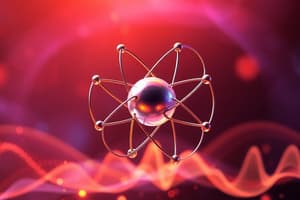Podcast
Questions and Answers
Which physicist developed the Planck Quantum Theory?
Which physicist developed the Planck Quantum Theory?
- Albert Einstein
- Max Planck (correct)
- Niels Bohr
- Isaac Newton
What did Planck's Quantum Theory propose about energy?
What did Planck's Quantum Theory propose about energy?
- Energy is related to the speed of light
- Energy is continuous and can be subdivided
- Energy depends on the size of the atom
- Energy comes in discrete, quantized packets (correct)
What is the role of the Principal Quantum Number (n) in an atom?
What is the role of the Principal Quantum Number (n) in an atom?
- It describes the position of electrons in the atom
- It represents the number of electrons in the atom
- It determines the spin of electrons
- It represents the main energy level of an electron in an atom (correct)
What did Quantum Numbers help us understand about electrons?
What did Quantum Numbers help us understand about electrons?
Which concept aimed to explain black bodies' emission and absorption of electromagnetic radiation?
Which concept aimed to explain black bodies' emission and absorption of electromagnetic radiation?
What does the azimuthal quantum number (l) represent?
What does the azimuthal quantum number (l) represent?
How many possible orientations does each subshell have based on the magnetic quantum number (m_l)?
How many possible orientations does each subshell have based on the magnetic quantum number (m_l)?
What does the spin quantum number (m_s) describe?
What does the spin quantum number (m_s) describe?
How do quantum numbers help us understand the distribution of electrons?
How do quantum numbers help us understand the distribution of electrons?
In atomic structure, what do the four quantum numbers together define?
In atomic structure, what do the four quantum numbers together define?
Flashcards are hidden until you start studying
Study Notes
Exploring the Structure of Atoms: Planck Quantum Theory and Quantum Numbers
In the realm of chemistry, delving into the structure of atoms unveils fascinating concepts like Planck Quantum Theory and Quantum Numbers. These fundamental principles are essential for understanding the behavior of subatomic particles and the very essence of matter.
Planck Quantum Theory
Developed by German physicist Max Planck in the early 20th century, Quantum Theory revolutionized our understanding of the microscopic world. The theory was introduced to explain the behavior of black bodies, particularly their emission and absorption of electromagnetic radiation.
Planck's Quantum Theory proposed that energy is not continuous, but rather comes in discrete, quantized packets called quanta. These quanta are indivisible units of energy that cannot be further subdivided. The energy quantum of photons, for instance, is the smallest unit of light, which has a fixed value that depends on the frequency of light.
Quantum Numbers
Quantum numbers are a set of four integers that describe the unique properties of an electron in an atom. These numbers help us understand the behavior of electrons and their distribution within the atom. The four quantum numbers are:
-
Principal Quantum Number (n): This number represents the main energy level of an electron in an atom. The nth energy level corresponds to a particular value of the principal quantum number. As n increases, the orbitals become farther from the nucleus, and the energy of the electrons also increases.
-
Azimuthal Quantum Number (l): Also known as the angular momentum quantum number, l represents the shape of electron orbitals. Orbitals belonging to the same principal quantum number but different azimuthal quantum numbers are said to be in different subshells. There are l+1 types of subshells for each value of n.
-
Magnetic Quantum Number (m_l): This number describes the orientation of an electron's orbital in space. Each subshell has m_l possible orientations, which correspond to the possible values of the electron's magnetic moment.
-
Spin Quantum Number (m_s): The spin quantum number describes the intrinsic spin of an electron. All electrons have a spin quantum number of +1/2 or -1/2, corresponding to their spin being up or down in a particular direction.
These four quantum numbers together define the behavior of electrons in an atom and help us predict its chemical properties.
The Role of Quantum Theory in Atomic Structure
Planck's Quantum Theory plays a crucial role in understanding atomic structure, particularly when it comes to the distribution of electrons in an atom. The theory provides a framework for describing electrons in terms of quantized energy levels and predicts the behavior of electrons in response to external stimuli, such as light absorption or emission.
Quantum numbers help us understand the distribution of electrons in different energy levels and subshells. This understanding is vital for predicting the chemical behavior of elements, as it allows us to determine the stability of an atom and its propensity to engage in chemical reactions.
In conclusion, the Planck Quantum Theory and Quantum Numbers are indispensable tools for understanding the structure of atoms. They enable us to predict the behavior of electrons and their distribution within the atom, which is essential for explaining the chemical properties of elements. By exploring these principles, we can deepen our understanding of the world around us and the fundamental nature of matter.
Studying That Suits You
Use AI to generate personalized quizzes and flashcards to suit your learning preferences.




